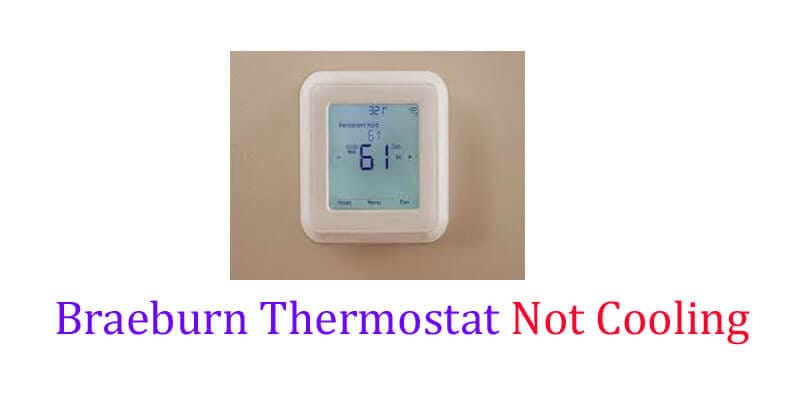Braeburn thermostat not cooling can be caused by low refrigerant levels or a dirty filter. Check the refrigerant levels and replace the filter if necessary.
A malfunctioning thermostat can be a huge inconvenience, especially during hot summer months. When a braeburn thermostat fails to cool properly, there are a few things to consider. Often, low refrigerant levels or a dirty filter can be the culprit.
In this article, we’ll cover the steps needed to troubleshoot the problem and resolve issues that prevent your braeburn thermostat from cooling properly. By following the tips and advice below, homeowners and technicians alike can get their air conditioning systems back up and running in no time.

Common Reasons For Braeburn Thermostat Not Cooling
If you’re experiencing issues with your braeburn thermostat not cooling, there are several common reasons why this may be happening. Below, we break down each possibility and provide guidance on how to effectively troubleshoot.
Air Filter Needs To Be Changed
One of the most common causes of a braeburn thermostat not cooling properly is a dirty air filter. A nonfunctioning air filter can impede proper airflow, making it harder for your cooling system to work efficiently. In some cases, a dirty air filter can even cause your system to shut down entirely.
That’s why it’s essential to change your air filter promptly, before it causes more significant problems.
If you’re unsure about the condition of your air filter, here’s how to assess it:
- Turn off your thermostat and locate your air filter.
- Pull out the filter and hold it up to the light.
- If you cannot see any light through the filter, it’s clogged and needs to be replaced.
Thermostat Settings Need To Be Adjusted
The next common issue that may lead to a braeburn thermostat not cooling could be a simple settings misconfiguration. You’ll want to double-check that your thermostat has the right settings configured for your air conditioning.
Here’s what to do:
- Turn off the thermostat.
- Begin by establishing your system on cool mode and setting the temperature to a lower temperature than the room’s current temperature.
- Double-check that your fan is set on auto mode and that your system is set to cool.
- Turn on your thermostat to check if the problem has been resolved.
Wiring Issues
Finally, a possible reason why you have a braeburn thermostat not cooling could be wiring issues. Faulty wiring may cause your system to shut down or trigger a warning or error messages. You should only make wiring changes if you’re confident in your abilities; otherwise, call a licensed technician to deal with it.
Here’s how to troubleshoot the wiring issues:
- Examine the wires running to your thermostat and identify any loose connections that may be producing electrical problems.
- Ensure that the power source is switched off before starting repairs.
- If you notice noticeable damage to the wiring or suspect that electrical issues are causing the problem, you should contact a qualified hvac technician to diagnose the problem.
We’ve identified three common reasons why people might run into issues with their braeburn thermostat not cooling: a dirty air filter, thermostat settings misconfiguration, and wiring issues. In troubleshooting these issues, you can help ensure that your home remains comfortable, safe, and energy-efficient.
Troubleshooting Steps To Fix Braeburn Thermostat Not Cooling
If you’re experiencing issues with your braeburn thermostat, specifically that it’s not cooling your space, it can be pretty frustrating. However, before you decide to replace it, there are a few troubleshooting steps you should take first. Here are the steps you need to follow to fix a braeburn thermostat not cooling.
Step 1: Check The Air Filter
One of the most common causes of air conditioning problems, including the thermostat not cooling, is a dirty air filter. A dirty air filter can reduce airflow, making it difficult for your air conditioner to effectively cool your space. Here’s what you need to do to check and potentially replace your air filter:
- Shut off the air conditioner completely before you begin.
- Locate the air filter panel, usually found near the return air duct or blower compartment.
- Open the panel and carefully remove the air filter.
- Inspect the air filter visually – if it’s dirty or clogged with debris, it’s time to replace it.
- Install a new air filter by following the manufacturer’s instructions.
It’s generally recommended that you replace your air filter every 1-3 months, depending on how frequently your air conditioner runs. Regularly changing your air filter can help prevent future problems, so make sure you stay on top of this task.
Step 2: Check The Thermostat Settings
Another common issue with air conditioning systems is a thermostat that’s not set correctly. Here’s how you can check your thermostat settings:
- Locate the thermostat on your wall.
- Make sure the thermostat is set to “cool” rather than “heat”.
- Check the temperature setting – it should be lower than the current temperature in your space.
- Verify that the fan on the thermostat is set to “auto” rather than “on”.
Common mistakes with thermostat settings include setting the temperature too high, the fan running continuously, and the temperature set to “heat” instead of “cool”.
Step 3: Check The Wiring
If your air filter is clean and your thermostat settings appear correct, the issue may lie in the wiring. Here’s how to troubleshoot potential wiring issues:
- Shut off the power to your air conditioner at the circuit breaker or main panel.
- Locate the thermostat wiring – it’s usually found behind the thermostat or in the air handler unit.
- Visually inspect the wiring to make sure it’s not damaged or corroded.
- Check the connections to make sure they’re tight and secure.
- If you notice any issues with the wiring or connections, call a licensed electrician to help you troubleshoot further.
Remember, if you’re not comfortable working with electrical wiring, you should always hire a professional electrician to help you make any necessary repairs.
By following these three steps, you should be able to solve the problem of a braeburn thermostat not cooling. Remember to keep your air filter clean, double-check your thermostat settings, and troubleshoot any potential wiring issues. With a bit of effort, you should be able to get your air conditioner back up and running in no time!
Other Possible Causes Of Braeburn Thermostat Not Cooling
If your braeburn thermostat is not cooling, it’s frustrating and inconvenient. Before calling a technician, try to diagnose the problem yourself. Apart from issues with the thermostat, several other factors may be responsible for the lack of cool air.
Refrigerant Leaks
One of the most common reasons for a braeburn thermostat not cooling is refrigerant leaks. The refrigerant in your unit absorbs heat from your home’s air, cooling it down. If the refrigerant is insufficient, the system will struggle to cool your home.
- Signs of refrigerant leaks include a hissing or bubbling noise when the ac is running, ice on the evaporator coils, and warm air blowing from the vents.
- If you suspect a leak, call an hvac professional. They’ll be able to assess the problem and recharge your refrigerant.
Dirty Or Damaged Condenser Coils
Another possible cause of an improperly functioning thermostat is dirty or damaged condenser coils. The condenser unit in your air conditioner is responsible for releasing the heat that the refrigerant absorbs from your home’s air. If the coils are dirty or damaged, they won’t be able to efficiently expel this heat.
- Regular cleaning of the coils is necessary to avoid accumulation of dust and debris, which reduces their effectiveness.
- If the coils are damaged, like bending, dents, or a hole, they must be replaced to restore effective function of the air conditioning unit.
Faulty Compressor
The compressor is the heart of your air conditioning system. If it malfunctions, it can lead to issues like a braeburn thermostat not cooling.
- Symptoms of a faulty compressor include strange noises like excessive vibration or grinding sounds, air blowing from the vents not being cool, and frequent thermostat shut-downs.
- A technician will assess all possible issues with the compressor and recommend repair or replacement.
By knowing the potential reasons for your braeburn thermostat not cooling, you’ll be better equipped to fix the problem or know what to tell your hvac technician. Keep your system in excellent condition with regular maintenance, which includes cleaning the coils and checking for refrigerant gas leaks.
Frequently Asked Questions On Braeburn Thermostat Not Cooling
Why Is My Braeburn Thermostat Not Cooling?
There could be several reasons for this, including dirty air filters, low refrigerant levels, or the unit itself being dirty or blocked.
What Should I Do If The Thermostat Is Not Turning On?
Check if the thermostat is receiving power, replace batteries if necessary, and ensure the circuit breaker is not tripped.
Can A Malfunctioning Thermostat Cause High Energy Bills?
Yes, if your thermostat is not functioning properly, it can cause your air conditioning unit to run constantly and increase your energy bills.
What Does The Low Battery Icon Mean On My Thermostat?
It means that the batteries in your thermostat are low and need to be replaced. Failing to do so can cause the unit to malfunction.
Can I Fix My Braeburn Thermostat On My Own Or Should I Call A Professional?
It depends on the issue and your level of expertise. Simple fixes such as checking the power source or replacing the batteries can be done on your own, but for more complex issues, it’s best to call a professional.
Conclusion
A braeburn thermostat not cooling can be a frustrating experience, especially during the hot summer months. Fortunately, there are many potential solutions available depending on the root cause of the problem. Some common causes to consider include faulty wiring, outdated firmware, or even a lack of proper maintenance.
Before taking any action, however, it is important to first properly diagnose the issue, which may require the assistance of a professional hvac technician. Additionally, regularly cleaning and inspecting your thermostat can go a long way in preventing future issues.
By taking the time to address any problems early on, you can ensure that your braeburn thermostat continues to provide reliable and efficient cooling for years to come.





